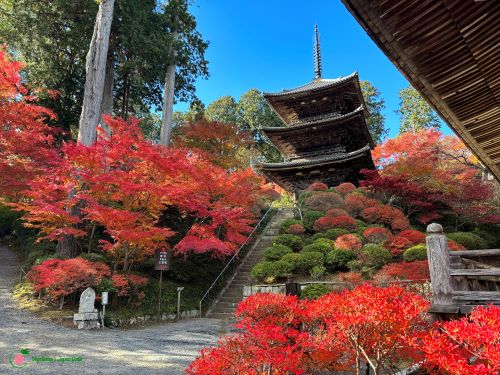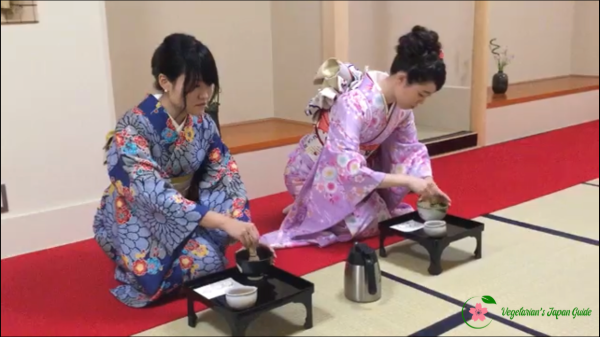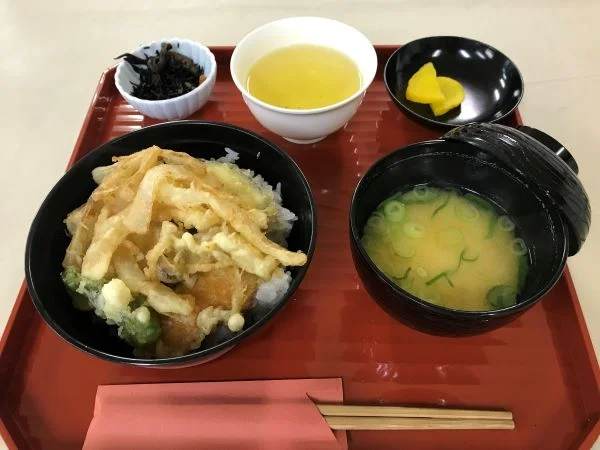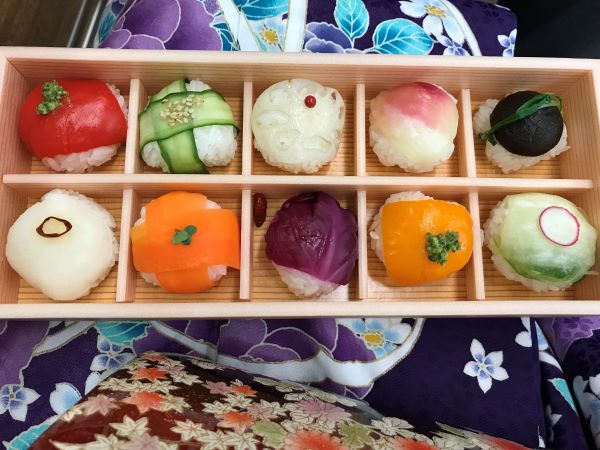In the Ishibe area of Konan City (湖南市), Chōju-ji (長寿寺) is a temple with breathtaking scenery. Adding to the temple’s charm, cute decorations and paper cutting art can be found throughout the precinct. Because it is located the eastmost among the city’s three temples that house a national treasure, Chōju-ji is also referred to as Higashi-dera (東寺).
Table of Contents
- Chōju-ji’s History
- The 120-meter Approach, Continued from the Sanmon Gate
- Japan’s Biggest Stone Pagoda (多宝塔)
- The National Treasure, Hondō (本堂)
- Benten-dō hall (弁天堂) and Hakusan Shrine
- The Ruins of the Three-Story Pagoda (三重塔跡)
- Shiun Falls (紫雲の滝)
- The Cherry Blossom and Fall Foliage Season at Chōju-ji
- Chōju-ji’s Opening Hours, Admission Fee, and Access Information

Chōju-ji’s History
In 724, when Emperor Shōmu (聖武天皇) succeeded the throne, he didn’t have any children. So Rōben (良弁), the monk who established the Tōdai-ji in Nara, performed a praying ritual at Mt. Aboshi’s (阿星山) waterfall. Soon after the ritual, the emperor was gifted with a princess.
A temple was then erected to pray for the longevity of the princess by Rōben at the emperor’s request in the 8th century. This is the origin of Chōju-ji and why the temple was named “Chōju”, meaning longevity.
Another role that Chōju-ji plays is guarding the Shigaraki Palace (紫香楽宮) against the attack of the demons and evil spirits coming from the northeast because, in ancient Japan, the gate that separated the human and demon realms was believed to be situated in that direction.
In fact, the purpose of Rōben’s ritual wasn’t just to pray for an heir for the emperor. At the time, the country suffered from severe natural disasters and epidemics. Although he wanted to improve the situation, he didn’t know what could be done to save his people. So Emperor Shōmu decided to seek help from Buddha.
Miraculously, after the ritual was completed, the situation got better.
Pleased by the effect of the Buddhist ritual, Emperor Shōmu requested dozens of temples to be established northeast of the Shigaraki Palace, and Chōju-ji was one of them.
In the Heian period (794 – 1185), Chōju-ji thrived as one of the biggest Tendai sect’s training grounds, with more than 5,000 sub-temples built around it to accommodate the disciples learning at Chōju-ji. Furthermore, the temple has been the prayer place for the Kamakura and Muromachi Shogunate.
The Capital of Japan in the Early 8th Century
As mentioned previously, Japan suffered from several natural disasters and epidemics under Emperor Shōmu’s reign. With so many unfortunate events happening simultaneously, the emperor thought it must be because the capital, Nara, was cursed. So, let’s move the capital and see if the situation will improve!
Based on this thought, the country’s capital was moved four times in just a couple of years. And here is the sequence.
- From the Heijō-kyō (平城京) in Nara to the Kuni-kyō (恭仁京) in Kyoto
- Then from Kyoto’s Kuni-kyō to Shiga’s Shigaraki no Miya (紫香楽宮)
- From Shigaraki no Miya in Shiga to Naniwa-kyō (難波京) in Osaka
- Lastly, and ironically, from Osaka’s Naniwa-kyō back to Nara’s Heijō-kyō
Since it became obvious that relocating the capital wasn’t helping the situation, he approached Rōben.
Chōju-ji’s Kuri (庫裏) and Naibutsu-dō (内佛堂)
The first complex on your left after passing Chōju-ji’s Sanmon Gate is called Kuri, which used to be the living quarters of the head priest and his family. After the family moved out, Kuri is now a small art gallery filled with astonishing paper cutting. Whether it is the small black dog at the entrance, the images on the paper lanterns, or the animal images reflected on the lacquered black table, many artworks were made by the head priest’s talented wife.
The small building behind Kuri, connected by a hallway, is Naibutsu-dō, where you will find a Jizō Bodhisattva Mandala scroll. Although it is a duplicate, the majestic Mandala has around 12,000 Jizō Bodhisattvas painted!
While the Mandala was completed centuries ago, the painting is rather contemporary. It looks like one of those large group photos where the Bodhisattvas form several rows and stand next to each other. So, only those in the front row have their whole body painted.


In addition to the painting hanging on the wall, check out the ceramic board on the table. The Mandala was reproduced in three-dimensional form so that those who are visually impaired can also “see” the Mandala. Feel free to feel the Jizō Bodhisattvas with your hand when you are there.
Parts of the images on the original Mandala are weathered, which is also replicated on the ceramic board.
You can also see the Mandala outside the worship hall, but please enter it through Kuri.
Important: Photos of the Mandala are not allowed without permission.

The 120-meter Approach Continued from the Sanmon Gate
Walking on the approach to the worship halls of Chōju-ji, you will notice many animal decorations placed under the trees at the side of the approach. Most of them are Shigaraki ware made from the Shigaraki Town closed by.
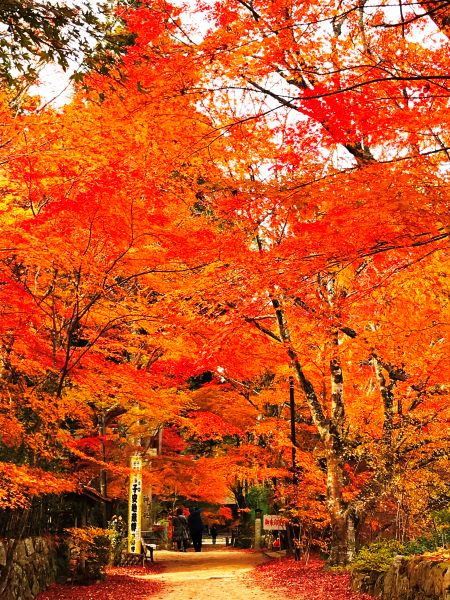
In the middle of the approach, the road splits. On the left is the approach to Chōju-ji’s guardian shrine, Hakusan Jinja (白山神社). While the exact established date remains unknown, it has existed since the Kamakura period (1185 – 1333).


Chōju-ji is also known for its power to grant child-related prayers. Naibutsu-dō is where you can make such prayers.
Close to Naibutsu-dō, there are a couple of small stone lanterns called Kodakara Tōrō (子宝灯籠). You can also pray to them for safe delivery or child conception.
Japan’s Biggest Stone Pagoda (多宝塔)
Proceeding further down the approach, there is a gigantic stone pagoda on your right at the end of a small path. It was built to pray for Emperor Shōmu (聖武天皇).
Apparently, the design is rare, and there are only around such stone 10 pagodas in Japan. The one in front of you is the biggest in the country.

The National Treasure, Hondō (本堂)

At the end of the approach, you will see the main worship hall, Hondō. The National Treasure with a cypress bark roof is the oldest architectural structure among all buildings in the three temples in Konan Sanzan.
Many statues in the building were designated as Important National Cultural Properties inside the worship hall, which are worth checking out!
Inside the altar in the middle of the Hondō, there is a Koyasu Jizō Bodhisattva (子安地蔵菩薩) enshrined. He is the Bodhisattva in charge of child-related matters. This statue was carved by Gyōki (行基), a highly regarded monk in Japan.
On the sides of Koyasu Jizō, Kannon Bodhisattva (観音菩薩) and Vaisravana (毘沙門天) are also enshrined.
Note that the Koyasu Jizō Bodhisattva, the Kannon Bodhisattva, and the Vaisravana are hidden images only exhibited once every 50 years. The next time you get to meet him will be in 2062. However, you can vaguely see them by looking at the bronze mirror hung in front of the altar.
Important: Photography is forbidden in Hondō.
The red Venerable Pindola Bharadvaja (賓頭盧尊者) statue is placed at Hondō’s entrance. If any part or parts of your body are unwell, stroke the same body part or parts of the statue. It is said that by doing so, you will soon recover from your illness.
You can also donate some money before you make a prayer.

Benten-dō hall (弁天堂)
Other than the main worship hall, Chōju-ji also has many important national cultural properties in its precinct, including the Benten-dō hall (弁天堂) next to the main worship hall.
In the small pond of the temple, the Benten-dō hall is quietly sticking out of the pond. The small but elegant hall was built in 1550 and is another photogenic spot in the temple.
The Ruins of the Three-Story Pagoda (三重塔跡)
Although Chōju-ji prospered as the center of Buddhism since its establishment, the scale of the temple was largely reduced after Oda Nobunaga relocated some of the most important buildings in the second half of the 16th century.
On the hill at the left of the Haiden Hall (拝殿) of Shirayama Shrine, there used to be a Three-story Pagoda standing. After Oda Nobunaga moved it to the Sōken-ji Temple (摠見寺) in Azuchi Castle ruins in Ōmi Hachiman City (近江八幡市), there are only a few foundation stones left on the ground now.

So if you want to see the pagoda, you have to travel north to Sōken-ji…
Furthermore, the tower gate was moved to the Rendai-ji (蓮台寺) in Ritto City (栗東市). As a result, the past glory was lost.
Shiun Falls (紫雲の滝)

If you have ever wondered where the magical waterfall where Rōben performed the ritual is, it is the Shiun Falls, close to the foot of Mt. Aposhi. From Chōju-ji, it is around a meter hike toward the summit.
It is said that when Rōben was here, some beautiful purple smoke rose from the waterfall. This is why the 3-meter waterfall was named Shiun Falls.
The Cherry Blossom and Fall Foliage Season at Chōju-ji
- The cherry blossoms at Chōju-ji usually bloom from early to mid-April.
- The autumn foliage at Chōju-ji usually peaks from mid-November to early December.
- One of the most popular photography spots in Chōju-ji is the 200-meter approach that fallen red leaves will cover in late November.
- In 2023, the Kōnan Sanzan Autumn Festival (湖南三山紅葉めぐり) was held from 9 am to 4 pm from the 10th to the 30th of November.
Chōju-ji’s Opening Hours, Admission Fee, and Access Information
- If you plan to take the Kōnan City Community Buses, get off at Chōju-ji (長寿寺).
- The bus trip will take around 15 minutes.
- Refer to our Konan Sanzan article for information about how to get to the bus stop.
- The temple is open from 9 am to 4 pm.
- The last admission is at 3:30 pm.
- For trip planning, allow 1 to 2 hours at Chōju-ji.
- The admission fee is
- 600 yen for adults
- 300 yen for high school students
- Free for elementary school students and below
Discover the Other Two Temples of Konan Sanzan
At the south of Japan’s largest lake, Lake Biwa, three temples were erected in the early 8th century. Each has a worship hall designated as a National Treasure in its precinct. Together, the three Tendai sect temples have been known as the Konan Sanzan.
Besides Chōju-ji, which we have just introduced, the other two temples are also worth a visit.
For more information, refer to our Konan Sanzan article!



